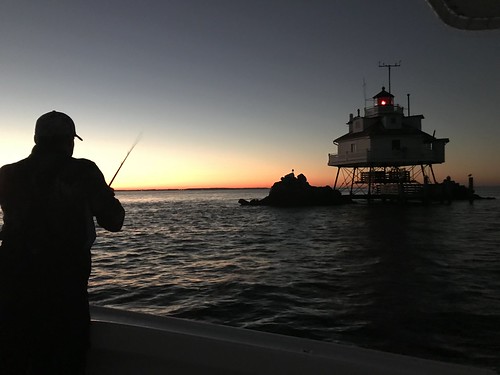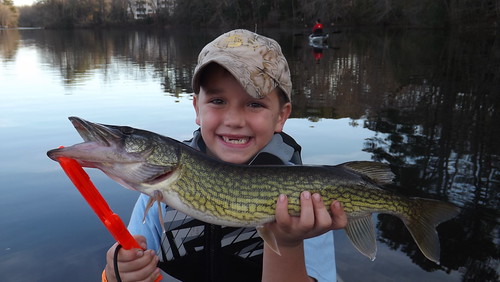Weekly Fishing Report: November 1
The fall months offer some exciting fishing opportunities for anglers across Maryland, from the trout management waters of Garrett County to the shores of Ocean City.
Daylight is getting sparser and this weekend the clocks fall back an hour, making it a little harder to get some fishing time after work and school. We’re all looking to stretch out fishing time as much as we can, always thinking: “Just one more cast.”
Before we get into this week’s fishing report, I wanted to remind everyone that they can submit their own fishing reports and photos to the Maryland Angler’s Log. To post a report, please email your name, hometown, photos, location information and additional content for your report. All information is optional, but encouraged. New reports are posted daily during the busy fishing seasons.
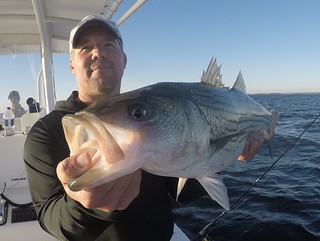
Things are looking up for Travis Long after connecting with this nice striped bass while jigging in the upper bay. Photo courtesy of Travis Long
Bay water temperatures continue to fall as cool nights and moderate daytime temperatures push water temperatures into the mid to low 60s this week. There seems to be 2- and 3-year-old striped bass everywhere, chasing bay anchovies. No matter which region of the bay you are fishing, these two age groups tend to dominate most of the surface action, and diving sea gulls usually mark the scene. Four-inch soft plastic jigs in a pearl pattern tend to be the best choice for casting to breaking fish; topwater popper-type lures can also be a lot of fun if you squash down the barbs so fish aren’t damaged when dehooking. If the wind is not blowing, this could be a good time to break out a 7-weight fly rod with a floating line and a skipping bug.
The upper bay region is offering some of the best opportunities for catching striped bass over 20 inches this week. At times they can be found underneath the surface action of smaller breaking fish; jigging deep with large soft plastic jigs (in the 8-inch or larger size range) offers the best chance of hooking up with a larger striped bass. Some anglers have had luck finding larger fish suspended along channel edges and deep structure.
Lately, the water releases at the Conowingo Dam have been sporadic, causing great variability in water flows in the lower Susquehanna River. A few striped bass are being caught in the dam pool in the mornings using topwater lures and crankbaits. Anglers fishing topwater lures in the mornings and evenings around the Susquehanna Flats have been mostly catching small striped bass. Casting topwater lures, jerkbaits and swim shads has been producing some keeper-sized striped bass in the early morning and evening hours at various locations throughout the upper bay region.
Trolling with medium to large bucktails, red surge tubes, swim shads and diving crankbaits has also been a good option for some in the bay and lower portions of tidal rivers. The lower Patapsco, Magothy and Chester rivers have been holding some larger fish. The Key Bridge and the Bay Bridge piers at about 30-foot water depth have been good places to jig or drift live eels.
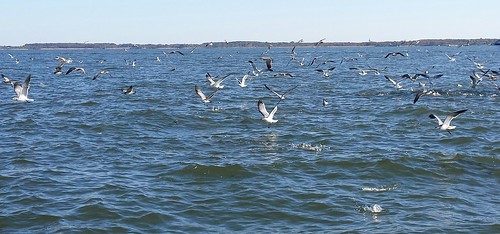
A sky thick with gulls and surface water erupting with fish is a sight to remember. Photo by Rich Watts
Fishing for white perch has been excellent in most of the lower portions of tidal rivers and in deeper waters over good hard bottom. Using bottom rigs baited with bloodworms has been popular, but jigging with dropper flies is also a great way to catch perch. Channel catfish are active in all tidal rivers and a simple bottom rig baited with cut bait will attract them.
The middle bay seems to be blanketed with small striped bass chasing bay anchovies at times, especially in the evenings. The mouths of the larger tidal rivers tend to see a lot of this action as bay anchovies and juvenile menhaden are moving out of the tidal rivers and into the bay. Water temperatures in the middle bay region are about 65 degrees now and will steadily decline as cooler weather becomes more consistent.
Casting to small fish can be fun for some catch-and-release action on light tackle, but if larger striped bass are your goal, there are some options. Jigging deep underneath the surface action can often pay off with larger fish, and you can find them suspended along steep channel edges with your depth finder. Eastern Bay has been producing some nice striped bass over the 20-inch mark whether one is jigging or trolling.
Trolling with a mix of medium-sized bucktails dressed with plastic twistertails, swim shads, red surge tube lures or slow trolling with diving crankbaits have all been catching fish. Trolling in about 15 feet of water in Eastern Bay, the lower Choptank, the lower West and the Severn has been producing fish.
The shallow water striped bass fishery in the middle bay region has been producing a few fish above the 20-inch mark, but smaller fish tend to be the most common size striking topwater lures and swim shads. Grass beds are diminishing, so submerged rocks tends to be the best places to find fish. The shoreline of Poplar Island, Thomas Point and submerged rip rap in the tidal rivers are good places to try.
White perch fishing remains good in the lower sections of the region’s tidal rivers. Good oyster bottom in about 20 feet of water or more usually is a great place to find perch schooled up this time of the year.
The lower bay region is providing some good fishing for larger striped bass in the lower Potomac River along the steep channel edge from St. George’s Island down to Cornfield Harbor. The lower Patuxent River has also been good and live lining the last remaining spot in the region has been a favorite way to catch them. Another good tactic is jigging with soft plastic jigs when these suspended fish can be spotted on depth finders.
Small striped bass in the 2- and 3-year-old age classes can be spotted making life miserable for bay anchovies throughout the region. Most of the bluefish have left so the smaller striped bass have the surface action all to themselves; deep underneath, 12-inch sea trout are also picking off bay anchovies, while the trout themselves are no longer being eaten by large red drum. At times large striped bass can be found while jigging under the breaking fish. Trolling can be a good option along 25-foot channel edges with larger swim shads, bucktails and red surge tube lures close to the bottom.
Casting soft plastic jigs, swim shads and topwater lures has been a fun way to fish this week along the shorelines on both sides of the bay. On the western side of the bay, striped bass make up most of the catch. On the eastern side of the bay there is also speckled trout in the mix. The marsh edges, creek mouths and the cuts through Hooper’s Island are good places to fish. Most of the striped bass tend to be small but some over 20 inches are caught now and then.
Now that water temperatures are in the mid to low 60s, recreational crabbing is just about over. There are crabs to be caught in deep water on trot lines and collapsible crab traps, and if one can wade through all of the sooks there are some large heavy crabs out there. Razor clams continue to be the bait of choice.
Weekly Fishing Conditions Forecast Summary – Nov. 1-8
Those pre-Halloween fronts moving through have had a big impact on bay conditions so expect changing fishing patterns. Main bay water temperatures have cooled 6 to 10 degrees in the past week, dropping down to the low 60s and upper 50s. The coolest waters are in the upper bay and upper Potomac River near the Woodrow Wilson Bridge. The warmer waters are found from the Gooses Reef south to the mouth of the Potomac River. Expect unstable weather patterns again for the next week. Conditions will be partly sunny but cool (65-75 degrees daytime, 55-60 degrees at night) Wednesday through Monday. However, there’s a chance of rain Sunday through Wednesday. Expect windy conditions Friday night into Saturday. Tuesday and Wednesday will be 10 degrees cooler both during day and the night.
Expect some reduced water clarity from the mouth of the Susquehanna down to Patapsco River as a result of recent rains. Reduced water clarity will also be present on the Potomac River down to near St. Clements Bay. In addition, the turbidity is also reduced in the Tangier Sound area. Otherwise normal flows for streams entering Maryland’s portion of the bay should not impact bay water clarity. In addition, there will be excellent tidal current conditions from now through Wednesday as a result of the full moon Nov. 4. Don’t forget to adjust your clocks for daylight saving time Sunday.
For more detailed and up-to-date fishing conditions in your area of the bay, be sure to check out the Eyes on the Bay Program’s Click Before You Cast.

Four-year-old Carson Hoffmaster sure looks like he had fun fishing at Calvert Cliffs Pond in Calvert Cliffs State Park and proudly holds up his catch. Photo by Brad Hoffmaster
The Deep Creek Lake area received the first snow of the season when about 3-4 inches fell during the past weekend. Cooler water temperatures in the lake have spurred the walleye and yellow perch fishery along steep rocky shorelines. Casting diving jerkbaits in the evening hours is a good tactic for the walleye and small jigs tipped with nightcrawler pieces or drifting minnows under a slip bobber work well in deeper waters near rocks or grass for yellow perch. Smallmouth bass will be holding on rocky points while northern pike are found near coves.
The rainfall over the weekend helped raise water levels in the upper Potomac and flush out loose grass that has been a pesky annoyance to fishermen. Better water flows will do a lot to spur on the smallmouth bass fishery. Tubes will be the lure of choice.
The fall trout stocking program has been a big success, providing plenty of good fishing opportunities. Many trout escape being caught immediately, so good trout fishing is not over by any stretch of the imagination. The catch-and-release trout management waters offer excellent trout fishing through the fall and winter months. Some of the ponds, lakes and rivers that were stocked still have plenty of trout for the next month to entertain those willing to fish for them.
Largemouth bass fishing continues in a typical fall pattern of fish behavior, as bass tend to hold near any existing grass that is in slightly deeper water or any kind of hard cover such as fallen treetops, stumps, sunken wood, rocks, channel edges and bridge piers. Largemouth bass will be on the lookout for baitfish and crayfish moving from diminished shallow cover to deeper cover. Small crankbaits, jigs and craws that resemble crayfish are good choice to work in the transition areas from shallow to deeper waters.
As grass beds diminish and waters cool, chain pickerel are more active and easier to target. Most tidal rivers have good populations of chain pickerel in the upper reaches and just about every impoundment in Maryland has them. Spinners, spoons and spinnerbaits are all good lures to use, and most chain pickerel are released, so consider removing the barbs from the treble hooks. Chain pickerel often strike lures with abandon and tend to get hooked deep in their mouths. Northern snakeheads can be encountered in almost any of the tidal rivers in Maryland and they will be roaming to some degree now that grass beds are disappearing.
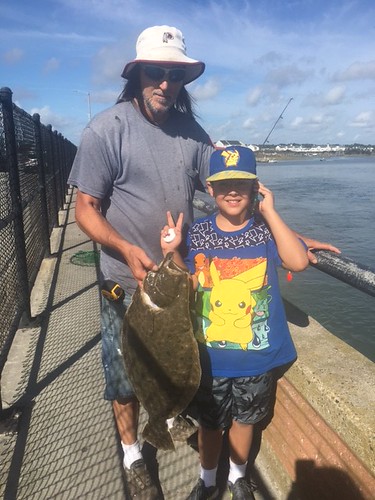
Eight-year-old Sean Whaley caught this nice flounder while fishing inside the Ocean City inlet with his dad. Photo by Lori Whaley
Yellow perch are becoming a more common catch in the tidal rivers and channel catfish are now very active. Crappie are schooling up near deep cover — marina piers and bulkheads, as well as fallen treetops and bridge piers. Small jigs, tubes or minnows under a slip bobber are good choices to fish for them. Fishing for a mix of walleye and smallmouth bass — with a chance at some trophy-sized fish — has been good in the lower Susquehanna River. Fishing for blue catfish in the tidal Potomac, Patuxent and Nanticoke rivers is very good this time of the year and offers a good opportunity to stock your freezer with filets for the winter months.
Cooling water temperatures at Ocean City are causing flounder to exit the back bay areas through the inlet, and tautog are moving into the inlet and Route 50 Bridge area. This time of the year offers some of the best flounder fishing and should not be missed. Larger baits will get you larger flounder so drifting live mullet, spot or small menhaden is a good bet, as are large scent-enhanced soft plastic baits on a jig head.
A mix of tautog and sheepshead are being caught along the jetties and Route 50 Bridge area on sand fleas and pieces of green crab. Surf fishermen are catching bluefish on cut bait and finger mullet, and a mix of stingrays and small sharks on larger baits.
Outside the inlet at the offshore reef and wreck sites, rail huggers on the party boats are reporting limit catches of sea bass and a mix of tautog, large flounder, large bluefish and ling. Clams have been the bait of choice for the sea bass, jigs with soft plastics for the flounder and metal jigs for the bluefish. The trolling action at the canyons is mostly over for the season and deep dropping for tilefish is about the only action out there.
“In the world of fishing, memory is only a bad thing in monofilament.” –Thomas Cocciardi
 ABOUT THE AUTHOR Keith Lockwood has been writing the Fishing Report since 2003 and has had a long career as a fisheries research biologist since 1973. Over the course of his career he has studied estuarine fishery populations, ocean species, and over a decade long study of bioaccumulation of chemicals in aquatic species in New Jersey. Upon moving to Oxford on the eastern shore of Maryland; research endeavors focused on a variety of catch and release studies as well as other fisheries related research at the Cooperative Oxford Laboratory. Education and outreach to the fishing public has always been an important component to the mission of these studies. Keith is an avid outdoorsman enjoying hunting, fishing, bird dogs, family and life on the eastern shore of Maryland.
ABOUT THE AUTHOR Keith Lockwood has been writing the Fishing Report since 2003 and has had a long career as a fisheries research biologist since 1973. Over the course of his career he has studied estuarine fishery populations, ocean species, and over a decade long study of bioaccumulation of chemicals in aquatic species in New Jersey. Upon moving to Oxford on the eastern shore of Maryland; research endeavors focused on a variety of catch and release studies as well as other fisheries related research at the Cooperative Oxford Laboratory. Education and outreach to the fishing public has always been an important component to the mission of these studies. Keith is an avid outdoorsman enjoying hunting, fishing, bird dogs, family and life on the eastern shore of Maryland.
Want the Weekly Fishing Report sent right to your inbox? Click here to sign up!

